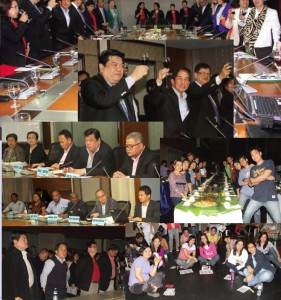 Taking off from its milestone last year, the Philippine Ports Authority is looking at sustaining the pace it has adopted as it slowly transforms Philippine ports to world standards.
Taking off from its milestone last year, the Philippine Ports Authority is looking at sustaining the pace it has adopted as it slowly transforms Philippine ports to world standards.
As it celebrates its 41st Founding Anniversary with the theme “Magkabalikat sa Pagsulong ng Ating Adhikain on 11 July 2015, PPA General Manager Juan C. Sta. Ana is encouraging the PPA Senior and Junior Executives to make a “one big push for 2015” and again try to find ways of providing excellent port services which correspondingly would result to increased customer satisfaction, port productivity and efficiency, and higher income for the organization.
The PPA Chief said that 2015 is another year for everyone to recharge and start a new and hopefully all extra effort that would create a multiplying effect to the country’s progress and growth and help the current administration leave a good legacy in terms of port operations.
The PPA has also line-up several projects in compliance with the different international regulations that will take effect starting at the end of the year like the Asean Economic Community wherein in the ports will serve as one of the major entry and exit points of commerce, trade and tourism to the rest of members of the 10-nation Association of Southeast Asian Nations. As of the moment, PPA is in the last stage of its initiatives in harmonizing its rules and regulations to guarantee the smooth implementation of the AEC at the end of this year particularly those policies related to Customs, Immigration, Quarantine and Security.
PPA, through the guiding hands of the Department of Transportation and Communications (DOTC), is likewise in the process of privatizing several ports starting with the Sasa Wharf in Davao. Considered as the major gateway for the country’s fruit exports particularly banana to the rest of the world, the privatization of the Sasa Wharf will give the port a major facelift that it has been needing the past couple of years. The dilapidated state of the port has dragged its operations to handle bigger volume of cargo and larger vessels forcing cargo owners to transfer some of its operations to nearby private ports. However, with the privatization process already underway and is expected to be completed before the end of the existing administration, the port is anticipated to get back its glory days and will remain as Davao’s main gateway to the world.
The state-owned agency also continues to undertake Repair and Maintenance work of the 115 ports under its watch to make sure that they respond to existing economic times particularly on safety, security and convenience.
The PPA also continues to invest on its employees as it continues to transition to be a ‘lean but mean’ organization through partnerships with different globally-known training institutions and agencies like the World Maritime University to train junior and senior officers of the PPA for some major aspects of port operations and other facets of maritime affairs.
“The Philippines, being a maritime nation, will benefit greatly in this endeavor particularly now as we bat to become one of the maritime superpowers in the world in terms of port operations, shipbuilding and manning and crewing,” Sta. Ana explained.
“The current problem clouting the Philippines with regard to its maritime schools and training institutes, tapping the capabilities of the WMU will greatly boost the competitiveness of the country’s seafarers in the world market,” Sta. Ana stressed.
“I am therefore encouraging not only the government sector, but most especially the private sector to assess their current structure and see how they can accommodate the proposals of the WMU in terms of the education and training of their employees both off- and on- shore,” Sta. Ana added.
“This program for PPA senior and junior officers as well as other qualified personnel is expected to complement the succession plan for the next batch of PPA officers,” Sta. Ana said.
Just recently, the PPA hosted a group of experts from the Japan International Cooperation Agency and the Department of Transport in Port Policy and Administration in Papua New Guinea, which is also aimed at Capacity Development of all parties involved.
The agency is also elevating several projects from last year to this year in its bid to support the overall dream of the Government to promote the country as one of Asia’s cruise tourism hubs through the development of several cruise ports like Davao, Bohol, Boracay, Cebu, Manila, Puerto Princesa, Subic, and Zamboanga. These make up the nation’s major nautical cruise arteries. It has also lined up various port programs for the development of cruise terminals. These include the Ports of Puerto Princesa, Currimao in Ilocos Norte and Catagbacan in Bohol Province.
“The administration of the Aquino Administration is coming to a close and before it ends, we are proud to say that the Philippine Ports Authority has done its part in making trade and tourism vibrant again,” Sta. Ana said.
“We are encouraging those who are next in line to continue the progress and changes we already introduced towards the overall dream of the Philippines to become a maritime super power,” Sta. Ana added.